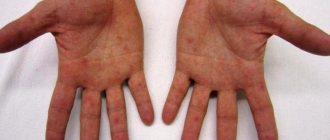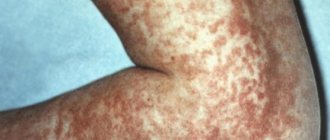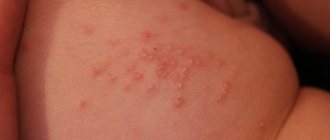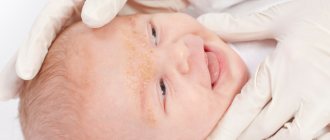Causes of red spots on the palate in children
In a child, red dots on the palate or throat are always a signal that unfavorable changes are occurring in the body. The rash can be found in children at any age. There are two main reasons for the appearance of red spots - an allergic reaction and the development of an infectious disease. In order not to miss the onset of a serious illness, a child with a rash on the upper palate should be shown to a doctor.
What if the rash is a different color?
The dots and spots that appear on the sky may be of other shades. Most often it is white, indicating the presence of pus in the boils. May appear with serious infectious diseases such as:
If your child has a rash on the roof of his mouth or throughout the oral mucosa, do not delay a visit to the doctor. Even in the absence of other symptoms (fever, nausea, vomiting, weakness), boils pose a danger to the child’s well-being. Parents should be advised: do not waste time guessing about the cause of the disease or searching for similar situations on forums.
A red rash in the mouth is a sign of an allergy
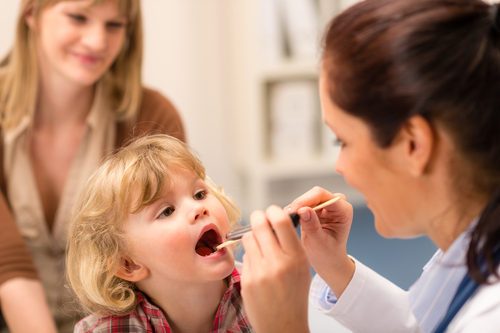
Allergies are caused not only by food or drinks, but also by toothpaste, mouthwash, and recently installed fillings or braces. You can distinguish an allergic reaction from an infection by the following signs:
- The location of the spots is symmetrical
- Sometimes the red dots merge with each other
- The sky around the spots remains light in color
- The rash on the palate does not itch, there is no burning sensation
- Additionally, skin rashes appear
If the red dots are the result of an allergic reaction of the body, then there are no signs of an infectious disease - fever, pain in the throat when swallowing and in the head, runny nose, cough, and mood changes do not appear.
The allergen should be identified as soon as possible, its effect on the mucous membrane should be eliminated, and the child’s body should be cleansed with the help of sorbents. If this is not done, the red spots will begin to enlarge and will soon turn into pimples, which will cause the child a lot of discomfort.
Red dots on the sky are a sign of an infectious disease
Much more often than an allergic reaction, the cause of red rashes in the mouth is bacterial, viral or fungal infections. Most often, red dots on the palate or in the throat are caused by thrush, flu, measles, stomatitis, colds, and herpes sore throat. In this case, diseases can affect not only the oral cavity and respiratory tract, but also other body systems - red dots in the mouth sometimes become a sign of blood diseases or vascular lesions.

Fungal infection
Thrush develops due to disturbances in the functioning of the gastrointestinal tract or changes in microflora. The Candida fungus causes the appearance of not only the well-known white rashes, but also red ones. The disease is diagnosed by a pediatrician, and therapy is carried out with antifungal drugs. During treatment, the dots darken to brown and gradually disappear.
Viral and colds of the respiratory tract
Most often, red rashes appear during the flu, however, they are not a mandatory symptom of this disease. Children always have such sensations as pain in the head, muscles, when swallowing, a feeling of a lump appears in the throat, the mouth becomes dry, a dry cough develops in the morning and at night, and the temperature rises. The points are located not only on the palate, but also on the throat.
Treatment is prescribed by a doctor and is aimed at relieving the symptoms of the disease and eliminating intoxication.

Herpes sore throat
The dots are located on the throat and look like bubbles with liquid, and the temperature in children rises to 40°C. The main symptom is severe pain in the throat when swallowing. The disease develops acutely and suddenly. Over time, the blisters open and ulcers appear in their place.
Treatment is carried out with medications against herpes infection, the temperature is reduced, and a gentle diet is prescribed. Food that can damage the inflamed mucous membranes - sour, spicy, hot, coarse foods - is excluded from children's diet.
Rash in the mouth due to stomatitis
Herpetic stomatitis, a sign of which are red dots on the palate, develops most often in children under 3 years of age. At this age, the immune system is just developing and cannot fully resist the virus. The main difference from herpangina is pain in the entire oral cavity, with an increase in temperature, loss of strength, and changes in behavior. During stomatitis, the rash in the child’s mouth looks larger than with a sore throat and covers the entire mucous membrane.
Treatment includes taking antiherpetic drugs, a gentle diet, and lowering the temperature.
Measles and red rash on the palate
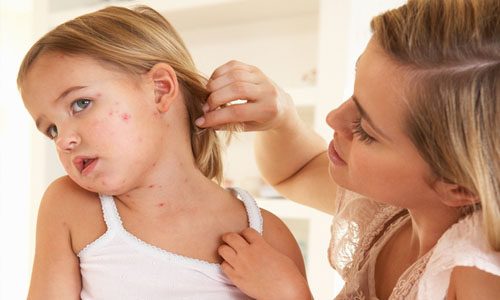
The disease usually occurs in children under 4 years of age. Small red spots of irregular shape appear on the palate a couple of days before the onset of the acute period of the disease. Then inflammation of the mucous membrane begins and the rash merges with it. When dots appear, measles can easily be confused with thrush or herpetic stomatitis.
Treatment is carried out at home, following all the pediatrician’s instructions.
Erythema infectiosum
The disease occurs in children with weakened immune systems or in the presence of chronic illnesses. Most often it affects children 4-12 years old. The initial symptoms are similar to a cold or viral disease - runny nose, headaches, sore and burning throat, sneezing, weakness. A rash on the palate appears on the 5th day of illness, but after it appears on the face. The spots on the mucous membrane look like blisters.
Treatment is carried out at home. Antiseptic, antipyretic, and analgesic drugs are used.
Infectious mononucleosis
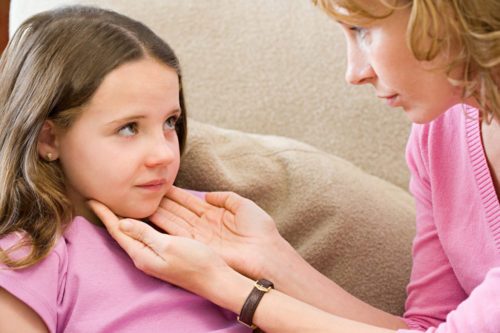
With this disease, red dots are located on the throat, which also turns red. Additionally, itching occurs, the tonsils become enlarged, and breathing becomes difficult.
Treatment consists of antiseptic treatment of the oral cavity, taking vitamins, and antihistamines.
Red dots on the sky are a symptom of some disease, so if they appear, you should always consult a doctor. Only a specialist based on the nature of the rash will be able to distinguish one disease from another, and therefore carry out the correct treatment. Rashes cannot be attributed only to allergies - the first place among the reasons leading to the appearance of dots on the palate is infectious diseases. To make a diagnosis, a specialist examines the child, prescribes urine and blood tests, and takes a swab from the throat.
Based on the results of the examination, antibiotics are prescribed for bacterial infections, antihistamines for allergies, and antiviral agents if viruses are the causative agents. Self-medication is unacceptable - the wrong medicine will only worsen the course of the disease.
Infectious diseases
Red rash - small red spots on the mucous membrane. It may be on the tongue, soft palate, or elsewhere inside the mouth. Red dots rarely indicate a serious illness. The two main causes are allergies or infections. There are other reasons. How to understand why a child has red dots on his palate?
The rash most often occurs in the larynx, on its back wall. At the same time, the child has a high temperature and sore throat. It hurts to swallow and makes you feel weak.
A red rash is usually a sign of a mild virus. If there is a whitish or some other shade of plaque on it, then this indicates the presence of pus. It appears in a wide range of diseases:
- scarlet fever;
- flu;
- meningitis;
- lichen;
- typhus and other diseases.
In this case, urgent hospitalization is necessary due to the danger of the disease. By the nature of the rash, you can determine what kind of infection has struck the person.
- That is why it is necessary to immediately take the child to a doctor who will accurately diagnose and prescribe treatment.
- Infections are divided into several types:
- viral;
- bacterial;
- fungal.
Fungal is most often thrush, which occurs due to poor functioning of the gastrointestinal tract. The microflora is disrupted, which can cause a rash. Thrush usually appears after taking antibiotics or due to decreased immunity. The rash in a child's throat is whitish. In this case, the doctor prescribes antibacterial medications that improve the functioning of the gastrointestinal tract. The spots turn brown and then disappear.
Bacterial usually appears due to streptococci. It occurs in the form of tonsillitis, scarlet fever, bacterial pharyngitis and tonsillitis. There is also a high temperature and a rash not only in the throat, but also on the body. Coughing is rare. Only an experienced doctor distinguishes a bacterial infection from a viral one. Don't hesitate to visit the clinic.
We invite you to familiarize yourself with Chamomile for the throat
Viral – ARVI, known to everyone. Along with the throat, the nasal passages always become inflamed and a runny nose occurs. The larynx feels sore, sometimes there is a feeling of a lump or as if something is stuck in the throat. It hurts to swallow, the child coughs dryly. The cough is especially severe in the morning and evening. The temperature rises, often accompanied by headaches and muscles throughout the body.
Description of the problem and its main causes
In medical practice, rashes on the mucous membranes are called enanthem. Such an unpleasant symptom can be a manifestation of various diseases. Before considering them in more detail, it is advisable to determine the typical or basic signs of enanthema:
- Localized on the hard or soft palate, it can spread to the surface of the tonsils and each cheek.
- Palpation is sometimes accompanied by pain.
- Outwardly it resembles red spots or dots, which are located separately or merge together.
- The pathology may be accompanied by a deterioration in the child’s general well-being (headaches, weakness, nausea and vomiting).
- Quite often there are problems with swallowing food.

Why do red dots appear on the palate of a child? The reasons for the development of pathology are varied. Only a pediatrician can give an exact answer to this question after a physical examination of a small patient, studying his medical history and laboratory diagnostic results. Most often, enanthema occurs as a manifestation of an allergy. In some cases, it is a consequence of infectious diseases of viral, fungal or bacterial etiology. Among them, the most common are the following: herpetic sore throat, stomatitis, measles. Below we will consider the main causes of rashes on the palate in young patients in more detail.
Red dots in the mouth: reasons for their appearance
A rash on the mucous membrane can manifest itself in various forms. But most often these are small spots or dots that have a reddish tint. Such symptoms are not a sign of serious illness, but they cause unpleasant or painful sensations and therefore require mandatory treatment.
We suggest you read: How to cure a cold on the lip without pain
Such symptoms can appear at any age - both in a child and an adult. Factors that provoke a rash on the roof of the mouth include:
- contact of fungi on the mucous membrane;
- infectious infections;
- vascular pathologies of the palate;
- allergic exacerbation in the body;
- any viral infection.
The appearance of red spots in the mouth and cheeks in children can also be caused by the varicella zoster virus (chickenpox), rubella, dermatitis or due to lichen infection. As a rule, such diseases have less stress on a child’s body than on an adult. In children they are more easily tolerated and leave virtually no complications.
In adults, such “childhood” diseases are observed much less frequently, but still they should not be completely excluded. Rashes on the roof of the mouth often appear in smokers.
Nicotine greatly irritates the mucous membrane, forming wounds and small ulcers in the form of red spots.
In addition, with prolonged smoking, the capillaries become very thin, which ultimately leads to the formation of vascular nodules on the mucous membrane.
A more precise reason must be determined by a doctor. Self-medication in such cases is unacceptable, since the current state of the disease can significantly worsen due to incorrect measures taken.
Allergic rash
An allergy in the oral cavity develops due to contact with a substance or object that causes a corresponding immune reaction.
In infants, such a reaction is possible to a new product in complementary foods. Toothpaste and brush material can have an impact on the body of older children. Sometimes the metal or plastic from which the dishes are made acts as an allergen. If a child has recently visited a dentist's office or wears braces, the body may have an atypical reaction to the components of the filling.
The following signs allow you to distinguish a common allergy from an infectious process in the oral cavity:
- The red dots on the child's palate are located symmetrically.
- The sky around the rash remains light in color.
- The rash does not itch or itch.
- It is possible that papules may appear on other parts of the body.
- There are no symptoms of body intoxication.
After confirming an allergic reaction, it is necessary to determine the source of the ailment and reduce contact with it. In this case, the rash goes away quickly and leaves no traces behind.

Viral and colds
Most often, reddish rashes on the palate appear with the flu. However, they are not a mandatory symptom of such an unpleasant illness. Young patients may complain of a feeling of a lump in the throat, muscle pain and pain when swallowing. Dry mouth in a child, cough and high temperature also accompany the flu.
Treatment of the disease is aimed at eliminating the main symptoms and stopping the process of intoxication of the body.

Viral diseases
What can cause the formation of red spots in the oropharynx? Theoretically, the cause of the pathological symptom can be any respiratory disease in which the infection is localized in the throat. Viral diseases are extremely rarely limited to damage to the laryngopharynx mucosa, so patients often complain of inflammation of the nasal mucosa and rhinitis.
Common diseases that cause sore throat in adults include:
Disease Typical manifestations
| flu | high fever, chills, headaches, dry mouth, erythematous rash on the walls of the throat, difficulty nasal breathing, muscle weakness |
| herpangina | febrile fever, vesicular rash in the oropharynx, abdominal pain, difficulty swallowing, hypersalivation, fibrous film on the throat mucosa |
| herpetic stomatitis | red throat, pinpoint rashes on the mucous membrane, burning and sore throat, aphthous formations in the mouth, swollen lymph nodes, painful swallowing |
| measles | high fever, hoarseness of voice, large red spots on the soft and hard palate, redness of the conjunctiva of the eyes, sneezing and photophobia |
| rubella | macular rash on the body, headaches, inflammation of the throat mucosa, red dots on the palatine arches and the back of the pharynx, cervical adenopathy |
| Infectious mononucleosis | fever, inflammation of the pharynx, swollen lymph nodes, pain when swallowing, red rashes in the oropharynx, weakness, migraine, high fever |
| viral pharyngitis | soreness in the laryngopharynx, dry cough, low-grade fever, difficulty breathing, small vesicles on the palatine arches and the back of the pharynx |
It is possible to reliably determine the cause of the appearance of an erythematous rash only after submitting a swab from the throat for virological and microbiological analysis.
If the mucous membrane of the laryngopharynx is strewn with white dots, most likely, the provocateur of inflammatory processes in the ENT organs is a yeast-like or mold fungus (candidal tonsillitis). Untimely treatment of diseases leads to the spread of infection and damage to the lower parts of the respiratory system, which can lead to the development of bronchitis, laryngotracheitis, pneumonia, etc.
Herpangina
Red dots on the child's palate and temperature often indicate the development of herpetic sore throat. This is a serious disease caused by the herpes simplex virus. It occurs in children of all ages, but infants and preschoolers are most vulnerable to it.
Among the main symptoms, pediatricians call pain and sore throat, dry mouth in a child. It becomes difficult for the baby to swallow, so many children refuse to eat. Fever is usually accompanied by weakness, nausea and vomiting, and apathy.
With herpetic sore throat, bubbles with clear secretion first appear on the palate and cheeks. After some time, they open, leaving behind painful erosions. They are the ones that have a reddish color. Treatment of the disease involves following a special diet and taking medications.
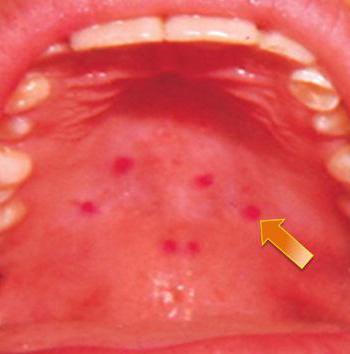
Mechanisms of appearance
Red dots around the eyes of a child - possible causes of the rash
Red spots in a child’s mouth are, in most cases, foci of inflammation. They are caused by the ingress of pathological microorganisms. Very often, rashes are the result of a child’s interaction with a sick person; most often, the child independently introduces germs into his body.
On a note. The mechanism of manifestation depends on the nature of the disease. The rashes themselves are not a disease, they are just symptoms.
Features of the course of measles
This disease has a viral etiology and is transmitted primarily by airborne droplets. Thanks to widespread vaccination, the disease is rarely diagnosed today. Children who are vaccinated according to an individual scheme have a high chance of becoming infected, when parents completely refuse vaccinations.
Measles begins its development with a common sore throat. The child may have a sore throat and cough. During this period, white-gray spots with a red border appear. They are localized on the buccal mucosa. After about 5 days, the rash spreads throughout the body. After another day, you can notice red dots on the child’s palate.
Measles responds well to treatment if it is started promptly. The disease is dangerous due to its complications.
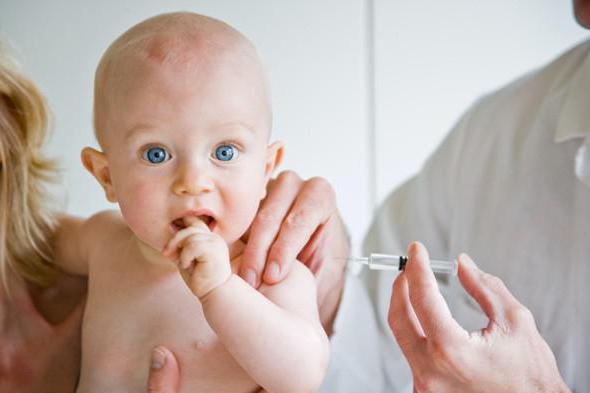
Features of therapy
If you notice red dots on your child’s palate, you should immediately contact your pediatrician. Your doctor may order a series of tests to determine the cause of the disorder. Only after this do they move on to the therapy itself. It is always selected individually.
For example, to eliminate a viral infection, treatment involves direct action on the source of the illness. At the same time, there is no need to treat even small red dots on the child’s palate with medications. After the virus is “removed” from the body, the rash goes away on its own.
Other causes of rash
According to experts, red dots on the palate of a child can form due to the following diseases:
- respiratory ailments;
- infectious diseases of blood vessels and blood;
- allergic manifestations.
We suggest you familiarize yourself with Prosthetics for periodontal disease, which dentures are better.
Having noticed a rash in the child’s mouth in a timely manner, in no case should you hesitate, trying to eliminate the problem using traditional medicine. It is recommended to immediately consult a doctor for the necessary diagnostic procedures. This will help you understand what the problem is as early as possible.
If the dots on the sky have a pale or grayish tint, they may be caused by an enterovirus infection. Localization of its manifestations usually occurs on the back walls of the pharynx in the form of ulcers. In this case, rashes can be found on the tongue, anterior arches of the palate, and tonsils. The main period for the spread of this disease in children is autumn, less often winter.
Causes in children and adults
The rash, which can be found on the roof of your mouth, usually appears as small spots and is most often red in color. This symptom can be explained by a variety of diseases and health problems, which can generally be divided into:
Much less often, a rash occurs due to physiological reasons. But if its appearance occurs against the background of complete health, it may well be that it was caused by natural factors.
An experienced doctor can find out the exact causes of rashes on the palate. If such a symptom is accompanied by fever and severe discomfort, you need to call a doctor at home, as the patient may be contagious.
Physiological factors
Sometimes red spots on the palate of a child or adult can appear as a result of the influence of fairly ordinary factors, for example, due to:
With physiological causes of the rash, it does not manifest itself in any way. Therefore, a person may notice its presence completely by accident.
Allergy on the palate

Isolated allergic manifestations on the palate are a rather rare variant of allergy, which, nevertheless, sometimes occurs and can be provoked by:
- Individual intolerance to dental materials.
- Using certain mouth rinses, toothpaste, etc.
- The use of certain medications, in particular antibiotics.
- Some food products, etc.
When an allergy develops in the oral cavity, a person most often experiences noticeable discomfort. You can visually see reddish dots or ulcers on the mucous membrane, and the palate hurts. Patients with this problem usually complain of:
- Pronounced burning sensation.
- Painful sensations when touching sores.
- Discomfort when eating food.
- Salivation.
The general condition of allergies in the mouth may not be disturbed at all, but sometimes the patient is also bothered by a slight increase in temperature and headache.
If you ignore unpleasant symptoms, the manifestations of the disease can merge with each other, forming a large erosive focus. Meanwhile, taking antihistamines after detecting signs of the disease makes it possible to stop its further development and causes dulling or even disappearance of unpleasant sensations.
Herpangina
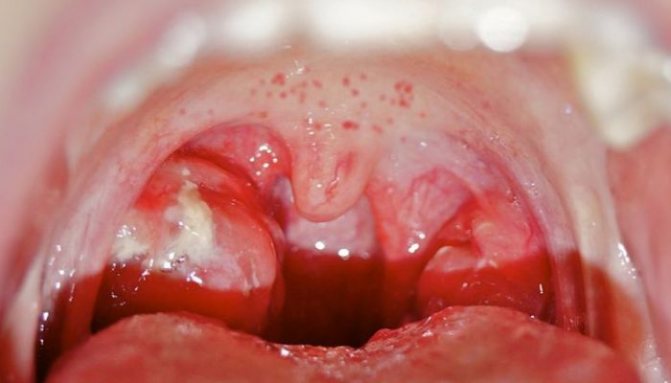
Perhaps it is herpetic sore throat that is the most common cause of the appearance of red dots on the palate. This disease has nothing to do with herpes (which is caused by the herpes virus) - it is caused by Coxsackie viruses. Herpetic sore throat has quite striking symptoms, especially if it develops in children. It provokes:
The main specific symptom of herpes sore throat is red spots-dots, which are localized in different parts of the oral cavity, namely:
- Soft sky.
- Posterior wall of the pharynx.
- Tonsils.
- Tongue.
Such spots quickly become reddish bubbles, filling with serous contents. Subsequently, they burst, dry out and gradually disappear.
In adults, herpes sore throat is less common than in children and most often occurs with less severe symptoms. Therefore, many people tend to carry it “on their feet,” thereby becoming a source of infection for others.
Children's infections with fever
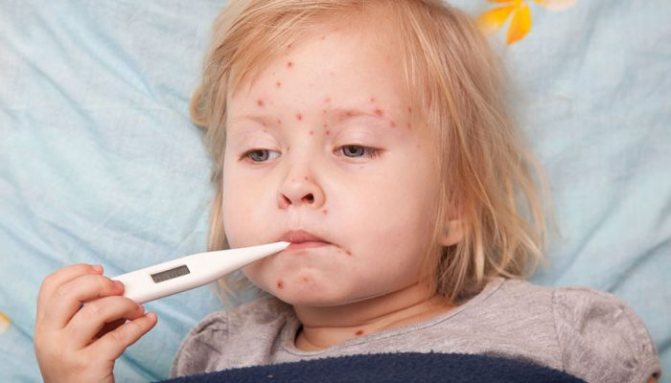
Red dots on a child's palate may be one of the signs of typical childhood infections. In particular, such symptoms may appear when:
It is worth considering that childhood infections may well develop in adults - in the absence of immunity. But in such patients these diseases are more severe and are often accompanied by complications.
All childhood infections are manifested by fever and signs of intoxication, and not just spots on the palate. The appearance of such symptoms is a reason to call a doctor at home.
Other diseases with red rash

Sometimes red formations on the palate that resemble a rash can be a sign of quite rare and even dangerous diseases, for example:
- Thrombocytopenia. In this condition, the patient's number of platelets in the blood decreases, which leads to increased bleeding. The spots on the sky in this case are broken capillaries.
Since a rash in the mouth can be a rather alarming sign, it is definitely not recommended to ignore it. Despite the fact that dangerous diseases are quite rare, it is better to be safe.
Stomatitis and herpes sore throat
These diseases deserve special attention, since their diagnosis occurs precisely according to the determination of the nature of the rash in the oral cavity. Despite the fact that the manifestations of both diseases are largely similar, their causative agents are different.
Herpes sore throat belongs to the category of enteroviral infections, which are characterized by sudden and acute development. The main distinguishing sign of the disease is small red spots on the roof of the mouth with transparent contents. Treatment is practically no different from measures aimed at eliminating ordinary ARVI. The patient will only have to adhere to a gentle diet, trying not to irritate the oral cavity with salty, spicy and hot foods.
As for stomatitis, it can be recognized not only by the rash, but also by the sudden appearance of chills and temperature fluctuations. The red dots on the child’s palate are somewhat larger here compared to herpes sore throat. Since stomatitis is a viral infection of herpes, any effective antiherpetic drug, for example, Acyclovir, is suitable for eliminating red spots in the mouth.
What to do if spots appear in the mouth and throat?
Having discovered strange spots in the mouth, you need to analyze the patient’s condition. If you have a fever or signs of intoxication, you must call a doctor at home. Before doctors arrive, you can use medications to reduce the temperature, for example, ibuprofen or paracetamol in an age-appropriate dosage.
If you feel absolutely normal, you should:
- Take any antihistamine in an age-appropriate dosage.
- Rinse your throat and mouth with a hypoallergenic antiseptic (for example, Miramistin).
- Monitor the patient's condition throughout the day.
The further strategy of behavior depends solely on the dynamics of the situation:
- If the spots disappear without a trace, most likely they were caused by natural factors. If this symptom reappears, it is better to consult a doctor to rule out possible health problems.
- If the patient’s health worsens, you need to call a doctor at home.
- If the spots do not disappear, but your health remains normal, you should consult your doctor as soon as possible. First, you need to go to an appointment with a regular therapist; if necessary, the doctor will send the patient to more specialized specialists.
Any incomprehensible changes occurring in the oral cavity should not be ignored. This sign can be quite alarming and indicate serious health problems.
Signs of enanthema - rashes on the oral mucosa
In some cases, malaise may be accompanied by rashes, the nature of which depends on the disease. Most often, enanthema is caused by bacteria or viruses. The baby's condition is characterized by the following symptoms:
- he complains of a sore and itchy throat;
- he has difficulty breathing;
- it hurts for the baby to swallow;
- there is pain and aches in the body;
- In the morning and evening the baby is bothered by a dry cough;
- there is an increase in temperature and signs of intoxication.
Causes of red dots on the throat and palate
There are many causes of enanthema. The most common causes of rashes are:
- fungal infection;
- diseases of a viral nature;
- allergic reactions.
Viral diseases
- One of the common causes of enanthema is the herpes virus. Thus, herpetic sore throat is characterized by high temperature and the appearance of blisters in the mouth - on the tonsils, on the inside of the cheeks, hard and soft palate (more details in the article: treatment of herpetic sore throat in children and photos). The blisters have a transparent or yellow tint and tend to burst, leaving painful erosions.
- Chickenpox can also cause similar symptoms. the causative agent of which is also a subtype of the herpes virus. During the illness, the child develops a rash all over the body, but in rare cases, red spots may also cover the oral mucosa.
- Also, the herpes virus provokes the development of stomatitis (we recommend reading: what stomatitis looks like in a baby and photos). This is a disease that most often affects newborns and children under 3 years of age. Blisters with stomatitis have a cloudy tint and cover the oral mucosa and palatine tonsils. As with herpetic sore throat, with stomatitis the temperature rises. In case of severe intoxication, hospital treatment is indicated.
- Enanthema can accompany ARVI - the throat becomes inflamed, becomes red, a runny nose and cough appear, worsening in the morning and evening. Headache and muscle pain are observed, and the temperature rises.
- Another disease, infectious mononucleosis, is characterized by a sore throat and red spots scattered throughout the throat mucosa. The child has difficulty breathing and enlarged tonsils.
- Red dots can form in the nasopharynx during measles. Recently, thanks to mass vaccination of children, this disease is extremely rare. The baby is at risk of contracting measles only if the parents refuse routine vaccination (we recommend reading: what measles looks like in children and photos). The disease begins with a sore throat, then the temperature rises, a runny nose and cough appear (see also: sore throat in children: symptoms with photos). At this time, several light spots with a red iris may appear on the mucous membrane of the mouth, which gradually spread to the mucous membrane of the throat and oral cavity.
Allergic reaction
Allergies in a child are caused by many factors. The cause of the rash can be various allergens - animal hair, certain foods, items of clothing or household chemicals. With allergic enanthema, the child does not have discomfort, fever or malaise. Allergic rashes are characterized by the following symptoms:
- no itching or burning;
- spots may merge together;
- there are light areas around the spots;
- a rash is possible both on the palate and on the entire body of the baby (see also: photo of stomatitis on the palate in children).
For diagnosis, you need to visit an allergist. Once the allergen has been identified, it must be eliminated - sometimes the child gets rid of unpleasant symptoms without treatment.
Fungal infection
A fungal infection (thrush) in babies is caused by fungi of the genus Candida (we recommend reading: how to treat thrush or candidiasis in a baby’s mouth?). The rash with this disease looks like small red pimples covered with a white coating. Often occurs in infants who are both breastfed and bottle-fed.
Causes of rashes in the mouth
A rash in the mouth of a child, like an adult, can occur for various reasons. Such a symptom cannot be ignored, believing that it will disappear on its own. The health of the baby depends on timely and correct treatment.
Allergic reaction
With an allergy, red dots appear on the palate, inner surface of the cheeks and tongue. A negative reaction is often accompanied by inflammation of soft tissues and swelling. In some cases, angioedema may develop, which can lead to suffocation.
An allergic reaction is caused by:
- Toothpaste;
- Food;
- Teethers, pacifiers and toys that the baby can taste;
- Medicines.
Infectious diseases
If the body encounters an infection, a rash usually appears on the roof of the mouth and tonsils. At the same time, the temperature rises, the general condition worsens, and a sore throat often bothers you. In children, herpes sore throat is most often diagnosed. Rashes also accompany ARVI, chickenpox, scarlet fever, and meningitis.
Note! Almost always, a rash occurs due to enteroviral infections. One of the manifestations, exanthema, is characterized by the hand-foot-mouth syndrome. Rashes in the form of small blisters begin on the face, then form on the palms, soles and mouth.
Bacterial rash in the oropharynx
The causative agents of bacterial infections that cause the rash are mainly staphylococci or streptococci. When they find themselves on the oral mucosa, they begin to actively multiply, which leads to the formation of ulcers. Later, small ulcers become noticeable in their place. Rashes begin with diseases such as scarlet fever, tonsillitis, pharyngitis.
READ ALSO: Skin care during pregnancy

